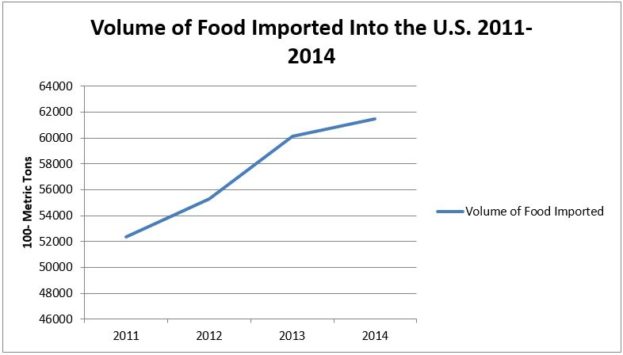The U.S. relies heavily on imported food to meet our demand for international cuisine and fresh produce year round.
In 2011 we reported that 20% of the food Americans eat each year is imported (How Much of U.S. Food Is Imported?). At that time FDA was just beginning to read the Food Safety Modernization Act (FSMA), which expanded their enforcement power and gave them more authority to inspect food facilities and regulate safety procedures. The Foreign Supplier Verification Program (FSVP) [go to FSVP.com to read more] and Hazard Analysis and Risk-Based Preventive Controls (Preventive Control Rules or HARPC) [see HARPC.com to learn more] are key aspects of how FDA will regulate food imports in the future.
From 2011 to 2014 (most recently published data), the total amount of food imports, by volume, increased by 17% (Fig. 1). At the same time, FDA developed the new FSMA rules to cover imported food safety. Though many of FDA’s rules are already in effect, FDA is not yet enforcing them with much vigor. One of the primary goals of FSMA is to place greater responsibility on importers to ensure imported foods and foreign suppliers meet compliance standards, to include testing individual imported food shipments.
In 2017, FDA prepared for an organizational realignment and restructuring. FDA’s Program Alignment Group’s recommendations included placing field import operations directly under the Director of Import Operations (previously each import program manager reported up through the districts and regions, rather than directly to headquarters). This reorganization enabled for more consistent imported product compliance decisions across ports, FDA districts and FDA regions. In addition, integration of agency systems improved risk based targeting for import examinations, import sampling and testing, and import detentions. These changes assisted FDA to better manage the ever increasing volume of food imports.
What we know is that the number of imported food shipments continues to rise – and has roughly doubled every five years since 1993 (passage of NAFTA). FDA will be responsible for as many as 40 million commercial lines of imported product and roughly 65% of them will be food shipments. FDA is increasing its resources for inspecting imported products, including foods. Through FSMA, FDA will be evaluating importers at a higher level of scrutiny. Even imported seafood, imported juice, imported dietary supplements and imported low acid canned foods and acidified canned foods will eventually come under programs similar to FSVP and HARPC. Knowing what is coming, how the new rules will be enforced, how FDA will approach food importers, and how to defend against FDA and Customs working together to enforce FSMA will be critical to surviving as a food importer in the coming years.
For more information or help with your imported food Contact Us Today!

Figure 1: A line illustration of the volume of food imported into the U.S. from other countries from 2011-2014.Excludes live meat animals. U.S. food import volume data from USDA, U.S. Dept. of Commerce, and Census Bureau.

